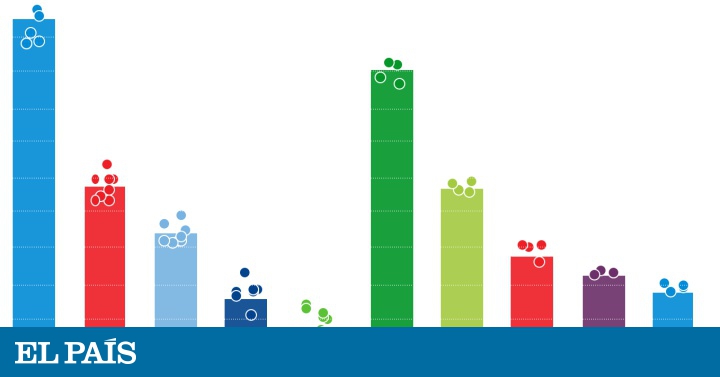Every week, Kiko Llaneras writes about politics with data and an analytical look. Sign up here to receive the newsletter in your email. Here is this Wednesday.
🗳 Good morning! Today I bring two summaries: one of the surveys in the Basque Country and Galicia, and another on the coronavirus and its numbers.
- In the US: Bernie Sanders is consolidated as a favorite in the Democratic race after his victory in Nevada. The next key date is Tuesday, when 15 coup votes vote to clear the main mystery: knowing if a clear rival against Sanders will emerge.
1. Surveys in Galicia and the Basque Country
The basics: the PP still has no guaranteed victory in Galicia; quite the opposite of the PNV, which will govern the Basque Country except catastrophe.
In Galicia the PP remains flat . In the February polls the popular ones are around 46% or 47% of votes. All polls give them the 38 necessary to have a majority, but their margin is narrow (three seats according to GAD3 and two according to NC Report and Metroscopy). The balance within the right is fundamental because the biggest risk of the PP is that Citizens and Vox subtract votes without converting them into seats.
- Citizens are around 1% or 2% in votes and it is difficult for a deputy to get if he attends separately from the PP. The two parties have not presented a coalition in Galicia, but they can still agree their lists. Advantage? Citizens would avoid a bad result and the PP would add 1% of votes to their conversion of seats.
- Nor does Vox have easy to achieve deputies. In November generals, he won 8% of the votes (above the 5% he now needs to enter the distribution of seats), but the regional surveys give him 4% and leave him out.
- And on the left? The PSOE will surely be the first force, although far from its November result (when it achieved 31% of the votes in Galicia). The BNG is the main beneficiary and is around 16% in the surveys.
In the Basque Country there is no intrigue. the PNV is almost assured to remain in the Government. The polls give him 40% of votes and 30 seats, more than enough to govern with the help of the PSOE, which already facilitated the investiture of Iñigo Urkullu in 2016 and has been his preferred partner in recent years.
- PP and Citizens add little. This week it has been confirmed that the two parties will present a joint list in the Basque Country. In the polls the PP is around 8% and Citizens 1%, very close to their results in the last generals. With an alliance they will improve their conversion of votes to seats - because Citizens' votes will not necessarily be lost - but it is difficult for them not to back off: the PP defends 9 seats; He was 13 in 2009 and 19 in 2001.
2. Order of magnitude: coronavirus
The basics: It is possible that the virus will spread in the form of a pandemic. The strategy so far had been to try to contain it in Wuhan: isolate the area, leave people at home and reduce contagion until the outbreak is extinguished. But the foci have multiplied in other countries and it seems increasingly difficult to contain the virus. This is not good, but it is a scenario that WHO already contemplated. It is also reassuring to remember that in 2009 there was already a swine flu pandemic.
- The "good" news: the coronavirus does not seem to be very lethal. The percentage of deaths from Covid-19 is between 2% and 4% in Wuhan Province and around 0.7% outside, according to WHO. The virus is more deadly than the common flu (0.1%) and the swine flu (0.2%), but less than the 2003 SARS outbreak (10%).
- The bad: yes it is very contagious. Their reproductive number (Ro) is estimated between 2 and 3 (I, II, III): that means that if no measures are taken, each patient infects 2 or 3 people. The patients multiply exponentially in a few weeks. Until where? This study estimates that an uncontrolled outbreak could infect between 5% and 40% of "susceptible individuals."
If there are no more infections it is because of the control measures. The Chinese authorities have reduced the reproductive number of the virus by putting Wuhan in quarantine. You can see it with this simulator from the University of Toronto: they estimate that there should be 300,000 infected, but there are only 80,000 because the Ro has been reduced. If that number falls below 1, as is perhaps happening in China, the outbreak is extinguished.
The problem? Outside China the virus expands. Perhaps exponentially: it took 20 days to add the first 400 infected outside the country, but then there have been 2,300 cases in 15 days (CSSE). And surely there are more undetected.
- In Italy it is rare that there are 10 dead and only 300 infected (assuming a mortality between 0.5% and 2%, there should be between 500 and 2,000). Nor do Iran's figures seem credible, where there are 16 dead, but only 96 cases have been confirmed. There could be many more: a group of Canadian researchers has used the three cases exported from Iran to estimate that there are between 3,000 and 50,000 infected.
Reminder: in 2009 there was already a pandemic. There was an outbreak of a new virus - H1N1 - that caused millions of infections and was impossible to contain. That virus is now one of the four types that cause the common flu in humans and circulates every winter around the world (CDC). One possibility if the coronavirus spreads is that something similar happens, as epidemiologist Marc Lipsitch told The Atlantic: "the cold and flu season could become the cold, flu and Covid-19 season."
- . Be careful with the argument "don't exaggerate the coronavirus because the common flu kills more". I think it works the other way around. That the common flu is a problem is a reason to try to contain the new virus: we don't want any more flu-like problems.
3. A random funnel
This is perhaps the largest funnel in the world. It is in the Monticello Dam (Napa Valley, California) and is exactly what it looks like: a 22-meter diameter drain that prevents the reservoir from overflowing. It looks good on Google Maps, but it is more impressive on video because the noise it makes is heard. | EngineeringVids
Can you help us? Forward this newsletter to friends and acquaintances, or ask them to sign up here. You can write me with ideas, suggestions, complaints and clue at: kllaneras@elpais.es. 📬






/cloudfront-eu-central-1.images.arcpublishing.com/prisa/S27CNMKITIAPNNGVWEGRZ6IMVI.jpg)
/cloudfront-eu-central-1.images.arcpublishing.com/prisa/EDZCE4O5FQYSLPIQ3ZOP6LWRCM.jpg)





